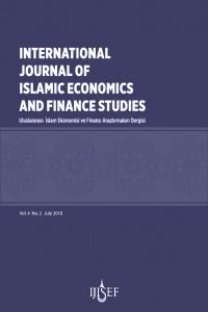Halal Conception and Other Factors Affecting Income Distribution in Islam
This paper examines and analyses the vital role of halal conception and its impact in mitigating and reducing the problem of unjust income distribution in our society. It also further expounds some relevant approaches to different economic systems in addressing income inequality. Generally, the conception of halal earning is not only associated with consumptions and devotional acts. Halal, in general, is a term that encompasses all aspects of lawful and unlawful in Islam including economic activities. For Muslims, halal earning is not only mandated by the Almighty God, but it is also indispensable for the acceptance of their religious acts. In relation to its significance in society, halal conception has indisputable impacts on the socio-economic problems of our society. Undeniably, one of the challenging economic issues in our society is the continuous rising of income inequality where the rich become richer and the poor become poorer. This unjust income distribution not only widens the undesirable gap between rich and poor people but also empirically brings socio-economic predicaments in our society. However, the conception of halal earnings is of remarkable mechanism can response the issue of unjust income distribution. Halal earnings can allocate economic resources efficiently and reduce income inequality in our society. The rising concentration of wealth in the hands of few rich individuals has something to do with high returns from proliferation of unlawful professions and economic activities in our society.
Keywords:
Halal Conception, İncome Distribution Earnings,
___
- Abdelrahman, AY (2013).Fundamental Issues in Islamic Economics. Germany: Verlag
- Ahmad, M. (2009). Business Ethics in Islam. New Delhi: KitabBhavan
- Al Zuhaili, W. (2005) Islam and international law. International Review of the Red Cross.
- Ali, Abbas (2014). Business ethics in Islam. UK: Edward Elgar Publishing
- Al-Jallad, N. (2008) The concepts of al-halal and al-haram in the Arab-Muslim culture: A translational and lexicographical study, University of Jordan, Language Design .10 (77-86)
- Al-Qaradawi, Y. (2001). The Lawful and the prohibited in Islam, Cairo: La-falah Foundation, for Translation, publication and distribution
- Al-Qaradawi, Y. (1997 Wealth and Economy in Islam, Cairo: Islamic INC Publishing
- Askari, H., Iqbal, Z., &Mirakhor, A. (2015). Introduction to Islamic economics: Theory and Application, Singapore: John Willey
- Ayub, M. (2007). Understanding Islamic finance. England: John Wiley & Sons
- Case, K., Fair, R. &Oster, S. (2012). (10th Ed.). Principles of Economics. England: Pearson Education
- Chapra, MU (1992). Islam and the Economic challenge. UK: The Islamic Foundation Hall
- Darussalam. (2014) Rizqand lawful earnings. Jeddah: Darussalam Publishers
- Daudey, E. &Penalosa, C. (2005).The Personal and the Factor Distributions of Income in a
- Dictionary of Economics (2003). London: A & C Black Publishers
- El-Ashker, A., & Wilson, R. (2006). Islamic economics: A short history. Leiden: Brill.
- Frank, R. & Bernanke, B. (2001) (4th Ed.). Principles of Microeconomics. NY: McGraw-Hill/Irwin
- Gupta, S. (1998). Does Corruption Affect Income Inequality and Poverty?. IMF Working Papers, 98(76), 1. http://dx.doi.org/10.5089/9781451849844.001
- Hall, R. & Lieberman, M. (2010) (5th Edition). Microeconomics: Principles & application. Mason, USA: South-Western, Cengage Learning
- Iqbal, Z. &Mirakhor, A. (2011) (2nd Ed) Introduction to Islamic Finance: Theory and Practice. Singapore: John Wiley
- Kaasa, A. (2003). Factors Influencing Income Inequality in Transition Economies. Estonia: Tartu University Press
- Kahf, M. (2014). Notes on Islamic Economics: Theories and Institutions. Westminster, USA.
- Kamali, MH. (2013) The Parameters of halal and and haram in Sharih and the Halal Industry. USA: The international institute of Islamic thought
- Karim, A. (2005). Islamic banking: Fiqh and financial analysis. Jakarta: PT Raja GrafindoPersada
- Krugman, W. & wells, R (2005). Microeconomics. New York: Worth Publisher
- Luetge, C. (Ed.), (2013). Handbook of the Philosophical Foundations of Business Ethics. London: Springer
- Mankiw, G. (2000). (2nd Ed.). Principles of Microeconomics. USA: Harcourt College
- Norris, E., Kochhar, K., Suphapiphat, N., Ricka, F. &Tsounta, E. (2015). Causes and consequences of Income Inequality: global Perspective. International Monetary Fund
- Oxfam’s International (2017). An economy for the 99%. Oxfam Briefing Paper file:///C:/Users/shldimakuta/Downloads/inequality/oxfam%20report%202017.pdf
- Sayer, R (2016). Why we can’t afford the rich. Bristol: Policy Press
- Shafi, Muhammad (1976). (6th Ed.) Distribution of Wealth in Islam. Karachi: Begum Aisha Bawany Wakf
- Todaro, S. & Smith, S. (2015) (12th Ed.). Economic Development. UK: Pearson Education
- Usmani, MI., & Qazi, B. (2010) Guide to Zakah: Understanding & Calculation. Pakistan: Maktaba Ma’ariful Qur’an
- ISSN: 2149-8393
- Başlangıç: 2015
- Yayıncı: Politik Ekonomik ve Sosyal Araştırmalar Merkezi
